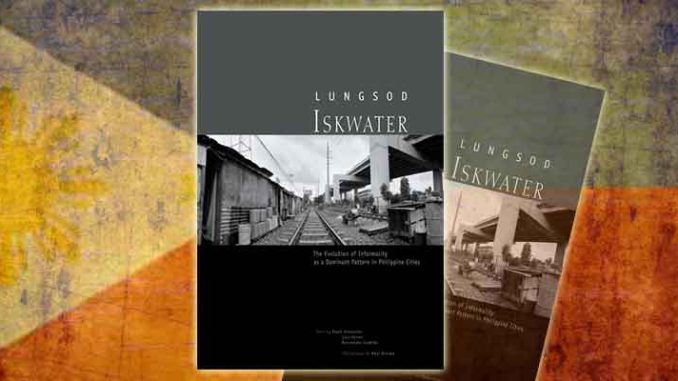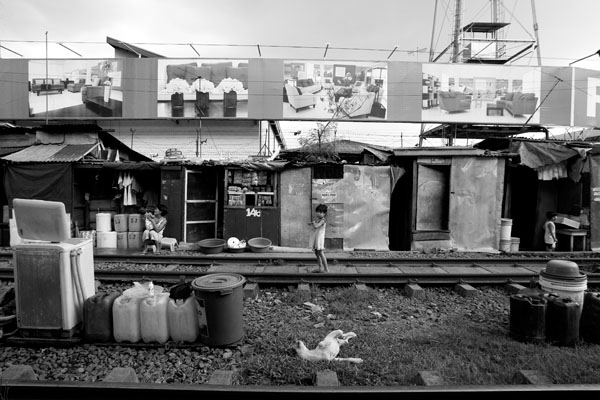
Alcazaren, Paulo, Luis Ferrer, and Benvenuto Icamina. 2011.
Lungsod iskwater: The Evolution of Informality as a Dominant Pattern in Philippine Cities.
Pasig City: Anvil.
Lungsod iskwater (Squatter City) is a book that seems to be full of self-contradictions. Its readers are likely to be confounded by the apparent incongruities in and between its form and content. However, far from weakening the work, these incongruities in fact are the strongest points of the book.
Firstly, there is the apparent disjunction between the medium and the message. The book talk about the evolution of informal settlements in Philippine cities and how their income-poor residents live, yet it is presented in a format that is similar to a coffee-table book. Large-sized, grayscale pictures dominate most its 30cm x 23cm glossy pages, but these are images of slums which are often viewed by the elite as eyesores.
Then, there are the gems of irony hidden in the contents of the book’s five chapters. Notwithstanding the precarious living conditions of its residents, the informal settlement is hailed in the book as “the most sustainable urban form in history” (x). Proving this point is an incisive historical analysis of Philippine urban development. Chapter one goes as far back as the sixteenth century to trace the roots of Manila’s urbanization and ends with the legacies of the Spanish regime. In the following chapter the focus shifts to the “dilemma” of twentieth-century urban living, predicated on the labor provided by an army of domestic servants and workers who also had their own housing requirements (p. 53). At the same time that suburban subdivisions were created for the wealthy to live separately from the poor, informal settlements became increasingly prominent. Chapter three is dedicated to the housing program of the Marcos years led by the Orwellian Ministry of Human Settlements, under which squatters were demonized and slums demolished (p, 74–75). Though Chapter four deals more with contemporary issues and current quantitative data, the insights are no less thought-provoking. One such insight is the profound yet overlooked impact of the informal economy on the sustainability of informal settlements. Informal economic activities make the informal communities “invisible cities” (p. 158); i.e., invisible to the middle and upper classes who are often too fixated on the supposed unsightliness of slums. The last chapter envisions the future for slum dwellers, anchored not in the purported salvific arms of the state or of philanthropists, but in the communities themselves.

The authors’ main argument is that, despite the embedded poverty, lack of access to services, and poor sanitary conditions, there is much to learn from informality. They see the potential in these settlements, with support from state authorities and collective action within the community, in terms of offering cheap yet secure housing for tens of thousands of households which cannot afford the relatively high cost of living in the metropolis. In a sense, informality is a pattern of living that can become an “ultimate” solution to our urban problems (p. 195).
Interspersed among the five chapters are three pictorial sections that provide more vivid details—details which will likely contradict the readers’ expectations regarding informal settlements. While the typical understanding of houses in informal communities revolves around their decrepit appearance, photos reveal a more complex reality. “Informal architecture” is presented as a form of coping mechanism by households to optimize the available materials and space, making these houses “feats of engineering” (p. 31). The photos also tell stories that go beyond the stereotypical image of urban squalor: houses with neat interiors (p. 122); unwritten codes governing privacy such as the use of a piece of blanket as a wall to demarcate intimate spaces (p. 120); and, residents who have pride of place in their ostensibly squalid settlements (p. 84).
These “contradictions” between expectation and presentation in Lungsod iskwater give the book an edge. Without falling prey to condescension or romanticism, the authors offer a sympathetic yet critical take on an important urban issue. The incongruities between form and content perhaps serve as a message in itself: as one does not judge a book by its cover, one should also not judge a community by its physical appearance. The slum is not just a way of life but a valid lifestyle worthy of appearing in coffee-table book format.
[quote]
“… the most sustainable urban form in history”
[/quote]

Another strong point of the book is the interdisciplinary effort behind it. Architect and columnist Paulo Alcazaren is the brains behind the historical depth of the work. The contribution of Luis Ferrer, also an architect and environment planner, is his analysis of the physical and structural aspects of informal housing. Probing the economic dimensions behind informal settlements is the main task given to Benvenuto Icamina, vice president and chief operations officer of the Wallace Business Forum. Lastly, Neil Oshima is the eye behind the lenses that captured the stunning images used in the book. The interdisciplinarity of Lungsod iskwater is not simply methodological, it is part of the argument. As the authors put it, the shortage in urban housing is not a problem that cannot be solved “with just architecture or urban design. The problem is economic, social, and cultural” (p. 75).
However, the book is not without its weaknesses. The most apparent is its Manila-centricity despite the national scope stated in its title. Areas outside Metro Manila are barely discussed and only in relation to their position as either sources of migrants or destinations for enforced relocations of urban poor residents. Although this weakness could have been easily addressed by delimiting the scope, the urban experience in cities like Baguio and Cebu warrants a similar investigation. Aside from that, the bibliography is only a modest sampling of the vast literature concerning Philippine urbanism. The bibliography ought to be more comprehensive if only to remind the reader that there is an ocean of scholarly knowledge that treats informal settlements as legitimate forms of urbanity.
That last point, together with the interdisciplinary character of the book, leads us to an important detail regarding its readership. The authors’ target audience is evidently the educated upper and middle classes who are in a position to initiate or influence urban housing policies. Its innovative interdisciplinarity is directed to them, including “practicing architects and planners, [and even] their clients like real estate developers, most of whom are still stuck in formulaic sprawl-based housing projects” (p. 194). The authors’ fervent hope is that the book will compel readers to rethink their ideas regarding disruptive and prescriptive policies such as forced relocation and resettlement.
To conclude, a final challenge to both authors and readers: what about the residents themselves? Although the book remains a conversation between middle-class intellectuals and the powers-that-be who can influence and initiate policies, the authors should be commended for pushing the reader to question the predominant image of informal settlers as hapless victims. Right now, many residents have already formed themselves into community associations to fight for security of tenure in their land (p. 178), although further empowerment is needed.
It may look like a coffee-table book, but clearly Lungsod iskwater is not meant for mere display but for the unsettlement of the reader.
Reviewed by Michael Pante
Kyoto Review of Southeast Asia. Issue 13 (March 2013). Monarchies in Southeast Asia
